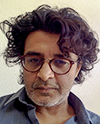Professor in Biomedical engineering at UC Davis (USA), Atul N. Parikh scientific interests lie in understanding materials science of soft matter and chemical biology of membranes, vesicles, and synthetic cells. Invited speaker at the International symposium on Chemical biology 2018, his talk on membrane behaviors out of equilibrium enchanted the audience. Today, he features in our portrait of a scientist series. In this interview, he shares with us his vision of research and unexpectendly gives a tribute to his graduate students.
Why are you active in the field of chemical biology?
From the chemical vantage point, I find it interesting that living systems, unlike their inanimate counterparts of interacting molecules, derive their functions through collaborations – such as occurs between molecules, reactions, even length- and time scales. How do these cooperative interactions arise, how are they turned on, and how are they shaped by evolutionary constraints? Learning about this spatial-temporal mode of molecular organization – which facilitates modular and dynamic organization under non-equilibrium, even active conditions – seems fascinating enough to keep me active.
Describe the most intense moment of your career.
Still waiting… No experiment has yet matched the adrenaline rush I got hooding Alan, Babak, and Michelle – my first three PhDs– on their convocation.
Which is the best idea you ever had?
That they rarely emerge from vacuum.
Do you have a role-model or a driving force?
A driving force. Witnessing the trajectory of the graduate students – from learning the tools of the trade to questioning the very paradigm. It gives me a great kick to be a part of that process. I have been influenced by one too many mentors, collaborators, and colleagues to isolate a single role-model.
The philosophy along which lines you lead your lab?
That the center of creativity is in the lab; my role is to try to tame it. Candidly, the philosophy is vulnerable to chaos, deviating from any scientific vision and mission statements of the lab, but unexpected findings make up for it.
Pick a paper you praise for the elegance of its demonstration.
Liphardt, J., Dumont, S., Smith, S. B., Tinoco, I. & Bustamante C., “Equilibrium information from nonequilibrium measurements in an experimental test of Jarzynski’s equality”, Science 296, 1832-1835, (2002).
Can you shed light on the relevance of inter-disciplinarity for scientific breakthroughs?
Distinct from multidisciplinarity, where several independent disciplines considers a scientific question from their respective vantage points, inter-disciplinarily offers something new. Here, we address a scientific question by blending approaches of different disciplines. I feel most outstanding questions in chemical biology demand such cross-disciplinary synthesis.
Define research with just three words.
Reproducible, falsifiable, tentative… Alas!..
How do you match the words beauty and science?
No match. I doubt that the beauty of an equation, elegance of a theory, or simplicity of a hypothesis is a reliable indicator of truth in science. There is however a kind of beauty, at least to the beholder, in the scientific mode of enquiry itself.
A piece of advice you’d like to give to the young generation of researchers?
We need to routinely ask ourselves why we do science in the first place…
A book, song, poem, music or painting that you spot out and get inspiration from?
D’Arcy Wentworth Thompson, “On Growth and Form” (Cambridge Univ. Press, Cambridge, 1917).
 Atul N. Parikh is a member of the faculty in the Departments of Biomedical Engineering and Materials Science & Engineering at the University of California, Davis. Since 2012, he is also serving as Visiting Professor in the school of Materials Science & Engineering at Nanyang Technological University in Singapore. He studied Chemical Engineering at the Department of Chemical Technology (UDCT), University of Bombay (B. Chem. Eng., 1987) and Materials Science (Emphasis: Polymer Science) at the Pennsylvania State University (PhD 1993). Between 1996 and 2001, as postdoctoral scholar and then technical staff member in the Chemical Science and Bioscience divisions at Los Alamos National Laboratory (LANL), he explored design of biologically inspired materials and biosensors. His research interests include materials science of soft matter and chemical biology of membranes, vesicles, and synthetic cells.
Atul N. Parikh is a member of the faculty in the Departments of Biomedical Engineering and Materials Science & Engineering at the University of California, Davis. Since 2012, he is also serving as Visiting Professor in the school of Materials Science & Engineering at Nanyang Technological University in Singapore. He studied Chemical Engineering at the Department of Chemical Technology (UDCT), University of Bombay (B. Chem. Eng., 1987) and Materials Science (Emphasis: Polymer Science) at the Pennsylvania State University (PhD 1993). Between 1996 and 2001, as postdoctoral scholar and then technical staff member in the Chemical Science and Bioscience divisions at Los Alamos National Laboratory (LANL), he explored design of biologically inspired materials and biosensors. His research interests include materials science of soft matter and chemical biology of membranes, vesicles, and synthetic cells.


Leave a comment
The editors reserve the right not to publish comments or to abridge them.